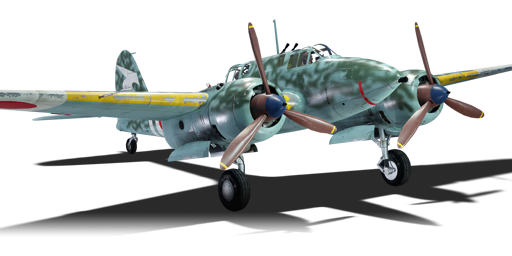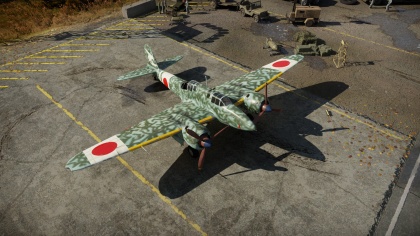Difference between revisions of "Ki-45 tei"
(Updated page template) |
Colok76286 (talk | contribs) (→Media: Added video) |
||
| Line 237: | Line 237: | ||
== Media == | == Media == | ||
| − | ''Excellent additions to the article would be video guides, screenshots from the game, and photos.'' | + | <!-- ''Excellent additions to the article would be video guides, screenshots from the game, and photos.'' --> |
| + | |||
| + | {{Youtube-gallery|hQB-vib08fc|'''Schräge Musik: a story of hesitation and confusion''' discusses the {{PAGENAME}} at 4:09 - ''War Thunder Official Channel''}} | ||
== See also == | == See also == | ||
Revision as of 14:11, 13 August 2020
Contents
| This page is about the Japanese twin-engine fighter Ki-45 tei. For other versions, see Ki-45 (Family). |
Description
The Ki-45 tei Toryu is a rank I Japanese twin-engine fighter
with a battle rating of 1.3 (AB), 1.7 (RB), and 2.3 (SB). It was introduced in Update 1.31.
Being a classed as a heavy fighter, the Ki-45 isn't the best in the manoeuvrability category. However, for a heavy fighter, it manoeuvres very well. It is even capable of out-turning aircraft such as the P-47D-25. Unlike heavy fighters of other nations, the Ki-45 series does not feature aircraft with large amounts of heavy weaponry. This is a major downside, considering how heavy fighters traditionally give up manoeuvrability and speed for armament. Instead, the Ki-45s utilize more of an equilibrium between manoeuvrability, speed, and armament. These are what makes the Ki-45 both a capable dog-fighter, and bomber hunter.
General info
Flight performance
Describe how the aircraft behaves in the air. Speed, manoeuvrability, acceleration and allowable loads - these are the most important characteristics of the vehicle.
| Characteristics | Max Speed (km/h at 6,300 m) |
Max altitude (metres) |
Turn time (seconds) |
Rate of climb (metres/second) |
Take-off run (metres) | |||
|---|---|---|---|---|---|---|---|---|
| AB | RB | AB | RB | AB | RB | |||
| Stock | 546 | 535 | 9900 | 25.2 | 25.6 | 16.5 | 16.5 | 520 |
| Upgraded | 590 | 570 | 23.7 | 24.0 | 23.0 | 19.5 | ||
Details
| Features | ||||
|---|---|---|---|---|
| Combat flaps | Take-off flaps | Landing flaps | Air brakes | Arrestor gear |
| ✓ | ✓ | ✓ | X | X |
| Limits | ||||||
|---|---|---|---|---|---|---|
| Wings (km/h) | Gear (km/h) | Flaps (km/h) | Max Static G | |||
| Combat | Take-off | Landing | + | - | ||
| 712.5 | 350 | 450 | 450 | 290 | ~11 | ~7 |
| Optimal velocities (km/h) | |||
|---|---|---|---|
| Ailerons | Rudder | Elevators | Radiator |
| < 360 | < 320 | < 450 | > 330 |
| Compressor (RB/SB) | ||
|---|---|---|
| Setting 1 | ||
| Optimal altitude | 100% Engine power | WEP Engine power |
| 1,800 m | 2,080 hp | 2,271 hp |
| Setting 2 | ||
| Optimal altitude | 100% Engine power | WEP Engine power |
| 5,100 m | 1,870 hp | 2,042 hp |
Survivability and armour
- 16 mm Steel plates behind the pilot
Armaments
Offensive armament
The Ki-45 tei is armed with:
- 1 x 37 mm Ho-203 cannon, nose-mounted (15 rpg)
- 2 x 20 mm Ho-5 cannons, Schräge Musik (100 rpg = 200 total)
Suspended armament
The Ki-45 tei can be outfitted with the following ordnance:
- Without load
- 2 x 250 kg Army Type 92 GPHE bombs (500 kg total)
Defensive armament
The Ki-45 tei is defended by:
- 1 x 7.92 mm Type 98 machine gun, dorsal turret (1,050 rpg)
Usage in battles
This variant of the Ki-45, the Ki-45 tei, features the first "schräge musik" armament of the series. Wielding one Ho-204 37 mm cannon and two Ho-5 20 mm cannons, the Ki-45 tei is the definition of a bomber hunter. It's 37 mm cannon allows the Toryu to take down bombers with ease, and its dual 20 mm cannons allow for even more flexibility in the bomber hunting department. Although deadly, the 37 mm cannon only holds 15 rounds, so shot placement is crucial. The round itself also travels fairly slowly in the air, making it hard to hit fast moving enemy fighters. The 20 mm cannons are best used in a secondary weapon role, as they are fixed at an upward angle. To use these weapons, one must bind a key to them via the in-game controls menu (it is on the first page that comes up, basic). Unique to the tei model, this Ki-45's ground attack role is improved due to the ability to equip bombs.
The Ki-45 tei also retains its impressive turn rate from the Ki-45 otsu. Although the aircraft itself is large and presents an "easy target" in many players' minds, the Ki-45 is rather nimble. Use this to your advantage when engaging enemy aircraft. Unfortunately, the Ki-45 is a heavy fighter, meaning its turn time is still not on par with other aircraft such as the F2A-3. In certain cases, the Ki-45 pilot may have to rely on his or her tail gunner to get the job done. The "tei" version of the Ki-45 features a 7.92 mm Type 98 machine gun with 1050 rounds. Although lacklustre, with shot placement it is possible to destroy enemies on the aircraft's tail. Aim for the pilot or the engine, as those are generally the weakest points on most aircraft. If the tailing enemy is a bi-plane, aim for the wings since they are very fragile.
The Toryu is also rather fragile for a heavy fighter. Although it does feature two engines, the Ki-45 does not have very much armour protection. Only the back of the pilot's seat and the nose has armour, leaving both the gunner and engines unprotected. This can prove costly in a fight. If one does find him or herself tailed, call upon teammates for assistance.
Manual Engine Control
| MEC elements | ||||||
|---|---|---|---|---|---|---|
| Mixer | Pitch | Radiator | Supercharger | Turbocharger | ||
| Oil | Water | Type | ||||
| Controllable | Controllable Not auto controlled |
Controllable Auto control available |
Controllable Auto control available |
Separate | Controllable 2 gears |
Not controllable |
Modules
| Tier | Flight performance | Survivability | Weaponry | ||
|---|---|---|---|---|---|
| I | Fuselage repair | Radiator | Turret 7 mm | 12 in (mod30) | |
| II | Compressor | Airframe | New 7 mm MGs (turret) | Offensive 20 mm | |
| III | Wings repair | Engine | New 20 mm cannons | ||
| IV | Engine injection | Cover | New 37 mm cannons | ||
- Instead of focusing on armament like other heavy fighters, the Ki-45 is more balanced between armament and flight performance. While the default ammunition belts for both weapons on the Ki-45 ko are workable, it can help to upgrade. Unlocking the flight performance modules will help drastically in dogfights and turn fights.
Pros and cons
Pros:
- Highly powerful 37 mm cannon
- Good manoeuvrability and climb rate for a heavy fighter
- Acceptable top speed
- 16.5 mm of armour in pilot's seat and added armour in the nose around cannon barrel
- Two engine design
- Capable of carrying 2 x 250 kg, unlike other Ki-45 variants
Cons:
- Beat in turn fights by some aircraft
- Prone to fuel and engine fires
- Locks up at high speeds
- Mediocre roll rate, gets worse as speed increases
- Limited ammunition for all weapons
- Lack of protection around fuel tanks, engines, and gunner
- Long cannon reload
- Pilot is exposed in head-ons
- Very little anti-fighter capabilities
History
Initially designed to be a bomber escort, the Ki-45 was first deployed in what is now China and Vietnam. It was found to be easily outclassed by P-40s piloted by the Flying Tigers. As a result, the Ki-45's role was changed to anti-shipping and ground attack, where it performed satisfactorily. Nonetheless, the Ki-45's greatest strength proved to be its bomber intercepting capabilities. Heavily armed with 37mm cannon, the Toryu (Dragon Slayer) could destroy heavy bombers with ease. As the war progressed, the need for an interceptor to defend the Japanese mainland was ever present. Soon, the Ki-45 was deployed to counter B-29 Superfortress raids. Although its armament was clearly deadly enough, the Ki-45 suffered at high altitudes. Pilots soon resorted to ramming attacks against the Superfortresses. Special attack groups specifically designed for this purpose formed, but by late 1945 Imperial Japan's fate had been sealed. The Allies allocated the name "Nick" to the Ki-45.
In-game description
Kawasaki Ki-45 KAI Tei (Model D) Type 2 Toryu (Allied reporting name: Nick) twin-engine army fighter
The Ki-45 KAI Tei fighter-bomber was built along with the night-fighter variant.
The armament on this version included one 37 mm Ho-204 cannon, with 15 rounds, mounted in the forward fuselage, and two 20 mm Но-5 cannons, with 100 rounds each, mounted at an angle in the upper fuselage.
Bomb racks were mounted under the centre wing section, one on each side of the fuselage, to suspend two 250 kg bombs.
The nacelles of the Mitsubishi Ha-102 engines had individual jet exhaust pipes to increase speed and reduce exhaust glow at night. Also, the barrels of the Но-5 cannons were equipped with flame arresters.
One Ki-45 KAI Tei aircraft was equipped with a 75 mm anti-tank gun, but its recoil proved to be too high for the fighter's relatively lightweight design.
Some early Ki-45s were also modified in the field to carry bombs. These planes were used at the end of the war by kamikaze pilots to perform suicide attacks.
Four Ki-45s were used by the Japanese for the plane's first suicide attack on Allied ships on May 28, 1944.
The Ki-45's production was discontinued in July 1945. A total of 1,701 Ki-45s were manufactured in all versions, including all prototypes and pre-production vehicles.
Media
See also
Links to the articles on the War Thunder Wiki that you think will be useful for the reader, for example:
- reference to the series of the aircraft;
- links to approximate analogues of other nations and research trees.
External links
Paste links to sources and external resources, such as:
- topic on the official game forum;
- encyclopedia page on the aircraft;
- other literature.
| Kawasaki Aircraft Industries (川崎航空機工業株式会社) | |
|---|---|
| Biplane Fighters | Ki-10-I · Ki-10-I C · Ki-10-II · Ki-10-II C |
| Fighters | Ki-61-I ko · Ki-61-I otsu · Ki-61-I hei · Tada's Ki-61-I hei · Ki-61-I tei · Ki-61-II Otsu Kai |
| Ki-100 · Ki-100-II | |
| Interceptors | Ki-45 ko · Ki-45 otsu · Ki-45 hei · Ki-45 tei |
| Ki-96 | |
| Ki-102 otsu | |
| Ki-108 Kai | |
| Bombers | Ki-32 |
| Ki-48-II otsu | |
| Captured | ␗Ki-45 hei/tei · ␗Ki-61-I otsu · ▃Ki-61-Ib |
| See also | Kawasaki Shipyard Co. |
| Japan twin-engine fighters and strike aircraft | |
|---|---|
| Navy | |
| Land-based Fighter | |
| J1N | J1N1 |
| J5N | J5N1 |
| Army | |
| Ki-45 | Ki-45 ko · Ki-45 otsu · Ki-45 hei · Ki-45 tei |
| Ki-83 | Ki-83 |
| Ki-96 | Ki-96 |
| Ki-102 | Ki-102 otsu |
| Ki-108 | Ki-108 Kai |
| Ki-109 | Ki-109 |





